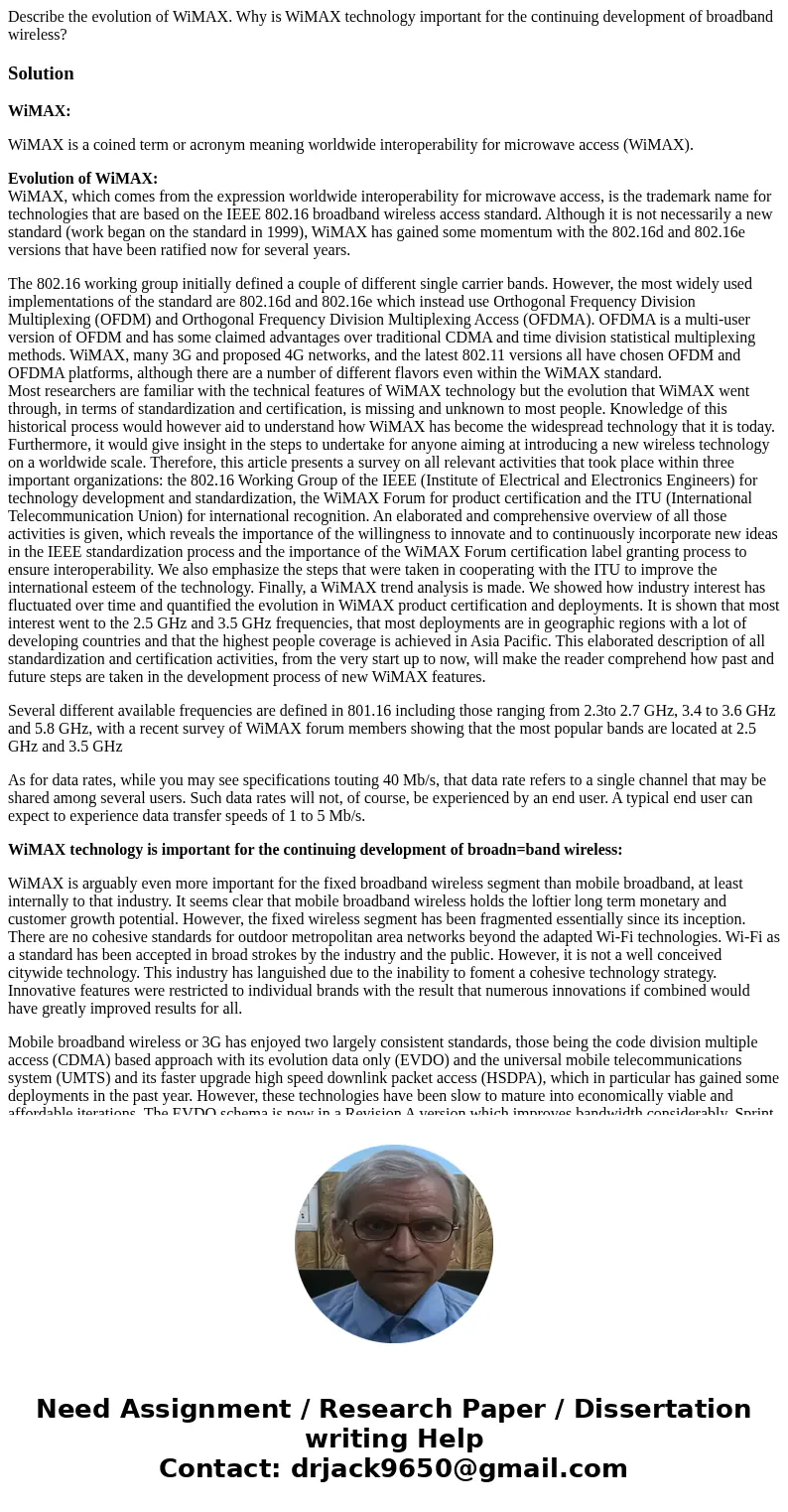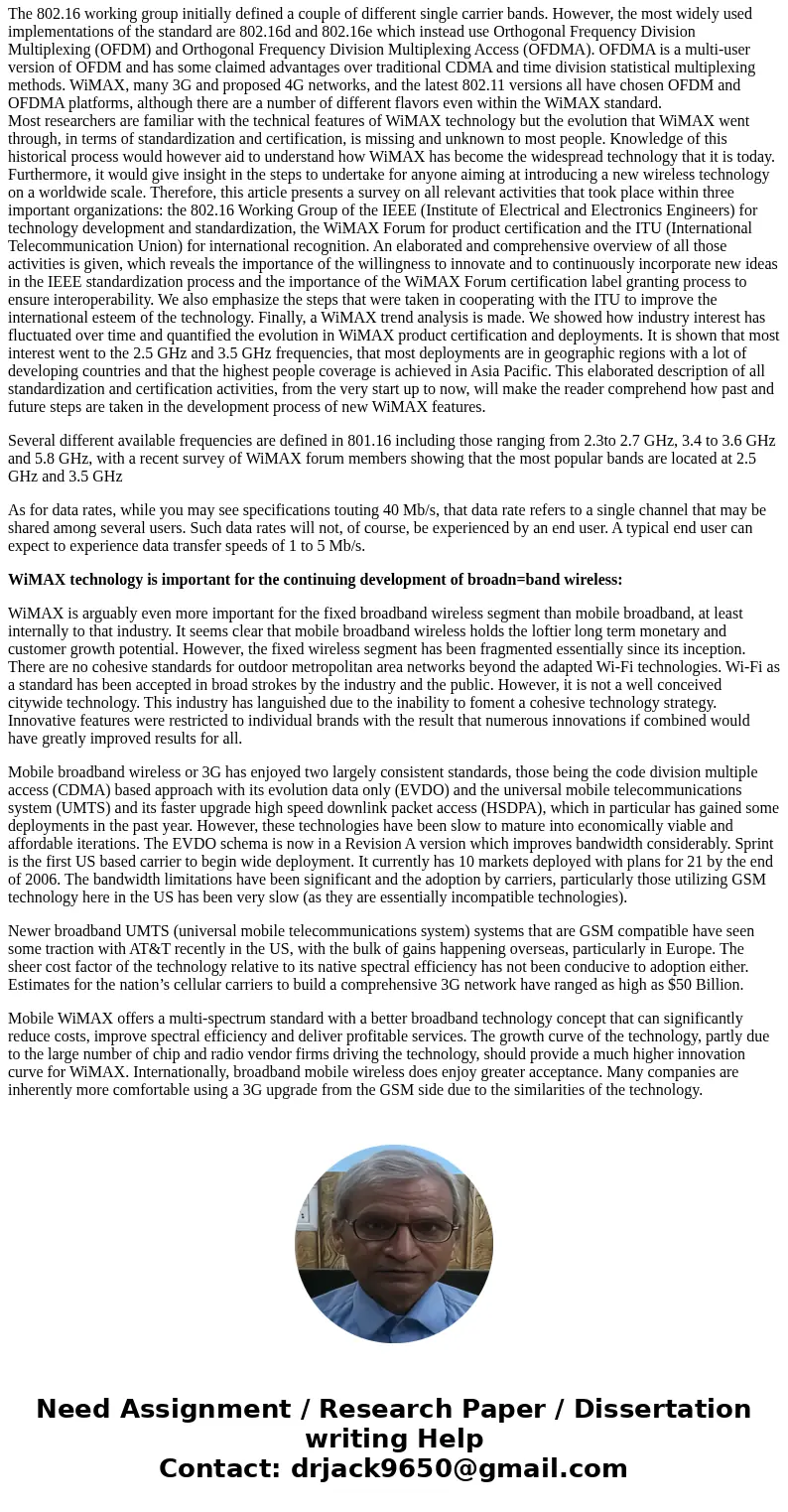Describe the evolution of WiMAX Why is WiMAX technology impo
Describe the evolution of WiMAX. Why is WiMAX technology important for the continuing development of broadband wireless?
Solution
WiMAX:
WiMAX is a coined term or acronym meaning worldwide interoperability for microwave access (WiMAX).
Evolution of WiMAX:
WiMAX, which comes from the expression worldwide interoperability for microwave access, is the trademark name for technologies that are based on the IEEE 802.16 broadband wireless access standard. Although it is not necessarily a new standard (work began on the standard in 1999), WiMAX has gained some momentum with the 802.16d and 802.16e versions that have been ratified now for several years.
The 802.16 working group initially defined a couple of different single carrier bands. However, the most widely used implementations of the standard are 802.16d and 802.16e which instead use Orthogonal Frequency Division Multiplexing (OFDM) and Orthogonal Frequency Division Multiplexing Access (OFDMA). OFDMA is a multi-user version of OFDM and has some claimed advantages over traditional CDMA and time division statistical multiplexing methods. WiMAX, many 3G and proposed 4G networks, and the latest 802.11 versions all have chosen OFDM and OFDMA platforms, although there are a number of different flavors even within the WiMAX standard.
Most researchers are familiar with the technical features of WiMAX technology but the evolution that WiMAX went through, in terms of standardization and certification, is missing and unknown to most people. Knowledge of this historical process would however aid to understand how WiMAX has become the widespread technology that it is today. Furthermore, it would give insight in the steps to undertake for anyone aiming at introducing a new wireless technology on a worldwide scale. Therefore, this article presents a survey on all relevant activities that took place within three important organizations: the 802.16 Working Group of the IEEE (Institute of Electrical and Electronics Engineers) for technology development and standardization, the WiMAX Forum for product certification and the ITU (International Telecommunication Union) for international recognition. An elaborated and comprehensive overview of all those activities is given, which reveals the importance of the willingness to innovate and to continuously incorporate new ideas in the IEEE standardization process and the importance of the WiMAX Forum certification label granting process to ensure interoperability. We also emphasize the steps that were taken in cooperating with the ITU to improve the international esteem of the technology. Finally, a WiMAX trend analysis is made. We showed how industry interest has fluctuated over time and quantified the evolution in WiMAX product certification and deployments. It is shown that most interest went to the 2.5 GHz and 3.5 GHz frequencies, that most deployments are in geographic regions with a lot of developing countries and that the highest people coverage is achieved in Asia Pacific. This elaborated description of all standardization and certification activities, from the very start up to now, will make the reader comprehend how past and future steps are taken in the development process of new WiMAX features.
Several different available frequencies are defined in 801.16 including those ranging from 2.3to 2.7 GHz, 3.4 to 3.6 GHz and 5.8 GHz, with a recent survey of WiMAX forum members showing that the most popular bands are located at 2.5 GHz and 3.5 GHz
As for data rates, while you may see specifications touting 40 Mb/s, that data rate refers to a single channel that may be shared among several users. Such data rates will not, of course, be experienced by an end user. A typical end user can expect to experience data transfer speeds of 1 to 5 Mb/s.
WiMAX technology is important for the continuing development of broadn=band wireless:
WiMAX is arguably even more important for the fixed broadband wireless segment than mobile broadband, at least internally to that industry. It seems clear that mobile broadband wireless holds the loftier long term monetary and customer growth potential. However, the fixed wireless segment has been fragmented essentially since its inception. There are no cohesive standards for outdoor metropolitan area networks beyond the adapted Wi-Fi technologies. Wi-Fi as a standard has been accepted in broad strokes by the industry and the public. However, it is not a well conceived citywide technology. This industry has languished due to the inability to foment a cohesive technology strategy. Innovative features were restricted to individual brands with the result that numerous innovations if combined would have greatly improved results for all.
Mobile broadband wireless or 3G has enjoyed two largely consistent standards, those being the code division multiple access (CDMA) based approach with its evolution data only (EVDO) and the universal mobile telecommunications system (UMTS) and its faster upgrade high speed downlink packet access (HSDPA), which in particular has gained some deployments in the past year. However, these technologies have been slow to mature into economically viable and affordable iterations. The EVDO schema is now in a Revision A version which improves bandwidth considerably. Sprint is the first US based carrier to begin wide deployment. It currently has 10 markets deployed with plans for 21 by the end of 2006. The bandwidth limitations have been significant and the adoption by carriers, particularly those utilizing GSM technology here in the US has been very slow (as they are essentially incompatible technologies).
Newer broadband UMTS (universal mobile telecommunications system) systems that are GSM compatible have seen some traction with AT&T recently in the US, with the bulk of gains happening overseas, particularly in Europe. The sheer cost factor of the technology relative to its native spectral efficiency has not been conducive to adoption either. Estimates for the nation’s cellular carriers to build a comprehensive 3G network have ranged as high as $50 Billion.
Mobile WiMAX offers a multi-spectrum standard with a better broadband technology concept that can significantly reduce costs, improve spectral efficiency and deliver profitable services. The growth curve of the technology, partly due to the large number of chip and radio vendor firms driving the technology, should provide a much higher innovation curve for WiMAX. Internationally, broadband mobile wireless does enjoy greater acceptance. Many companies are inherently more comfortable using a 3G upgrade from the GSM side due to the similarities of the technology.


 Homework Sourse
Homework Sourse